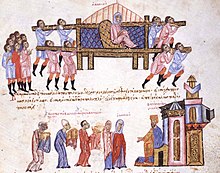
Justinian I, also known as Justinian the Great, was the Eastern Roman emperor from 527 to 565.
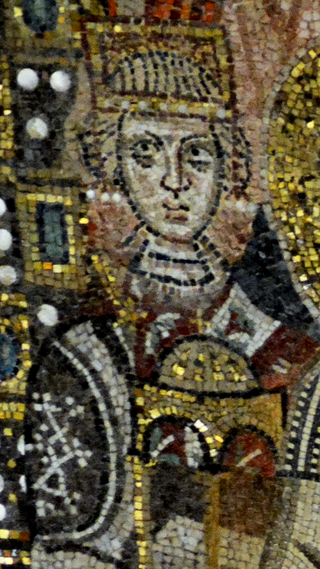
Justinian II, nicknamed "the Slit-Nosed", was the last Byzantine emperor of the Heraclian dynasty, reigning from 685 to 695 and again from 705 to 711. Like his namesake, Justinian I, Justinian II was an ambitious and passionate ruler who was keen to restore the Roman Empire to its former glories. However, he responded brutally to any opposition to his will and lacked the finesse of his father, Constantine IV. Consequently, he generated enormous opposition to his reign, resulting in his deposition in 695 in a popular uprising. He only returned to the throne in 705 with the help of a Bulgar and Slav army. His second reign was even more despotic than the first, and in 711 he was killed by mutinous soldiers.

Theodora Porphyrogenita was Byzantine Empress from 21 April 1042 to her death on 31 August 1056, and sole ruler from 11 January 1055. She was the last sovereign of the Macedonian dynasty, that ruled the Byzantine Empire for almost 200 years.
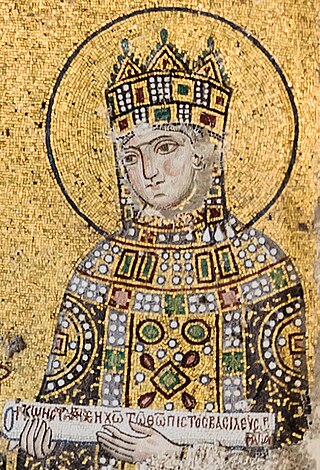
Zoe Porphyrogenita was a member of the Macedonian dynasty who briefly reigned as Byzantine empress in 1042, alongside her sister Theodora. Before that she was enthroned as empress consort or empress mother to a series of co-rulers, two of whom were married to her.
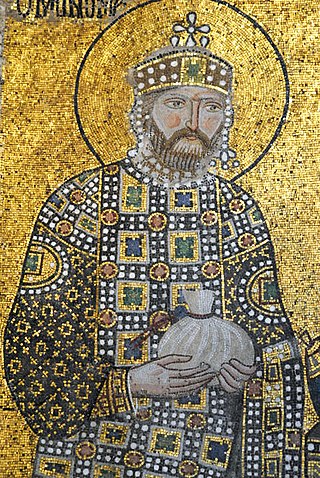
Constantine IX Monomachos reigned as Byzantine emperor from June 1042 to January 1055. Empress Zoë Porphyrogenita chose him as a husband and co-emperor in 1042, although he had been exiled for conspiring against her previous husband, Emperor Michael IV the Paphlagonian. The couple shared the throne with Zoë's sister Theodora Porphyrogenita. Zoë died in 1050, and Constantine continued his collaboration with Theodora until his own death five years later.

Throughout the fifth century, Hellenistic political systems, philosophies, and theocratic Christian-Eastern concepts had gained power in the eastern Greek-speaking Mediterranean due to the intervention of important religious figures there such as Eusebius of Caesarea and Origen of Alexandria who had been key to developing the constant Christianized worldview of late antiquity.

Theodora, sometimes called Theodora the Armenian or Theodora the Blessed, was Byzantine empress as the wife of Byzantine emperor Theophilos from 830 to 842 and regent for the couple's young son Michael III, after the death of Theophilos, from 842 to 856. She is sometimes counted as an empress regnant, who actually ruled in her own right, rather than just a regent. Theodora is most famous for bringing an end to the second Byzantine Iconoclasm (814–843), an act for which she is recognized as a saint in the Eastern Orthodox Church. Though her reign saw the loss of most of Sicily and failure to retake Crete, Theodora's foreign policy was otherwise highly successful; by 856, the Byzantine Empire had gained the upper hand over both the Bulgarian Empire and the Abbasid Caliphate, and the Slavic tribes in the Peloponnese had been forced to pay tribute, all without decreasing the imperial gold reserve.
Logothete was an administrative title originating in the eastern Roman Empire. In the middle and late Byzantine Empire, it rose to become a senior administrative title, equivalent to a minister or secretary of state. The title spread to other states influenced by Byzantine culture, such as Bulgaria, Sicily, Serbia, and the Danubian Principalities.

Theodora was a Byzantine empress and wife of emperor Justinian. She was from humble origins and became empress when her husband became emperor in 527. She was one of his chief advisers. Theodora is a saint in the Eastern Orthodox Church and the Oriental Orthodox Church, commemorated on 28 June.

The Byzantine economy was among the most robust economies in the Mediterranean for many centuries. Constantinople was a prime hub in a trading network that at various times extended across nearly all of Eurasia and North Africa. Some scholars argue that, up until the arrival of the Arabs in the 7th century, the Eastern Roman Empire had the most powerful economy in the world. The Arab conquests, however, would represent a substantial reversal of fortunes contributing to a period of decline and stagnation. Constantine V's reforms marked the beginning of a revival that continued until 1204. From the 10th century until the end of the 12th, the Byzantine Empire projected an image of luxury, and the travelers were impressed by the wealth accumulated in the capital. All this changed with the arrival of the Fourth Crusade, which was an economic catastrophe. The Palaiologoi tried to revive the economy, but the late Byzantine state would not gain full control of either the foreign or domestic economic forces.

The Byzantine Empire, also referred to as the Eastern Roman Empire, was the continuation of the Roman Empire centered in Constantinople during Late Antiquity and the Middle Ages. The eastern half of the Empire survived the conditions that caused the fall of the West in the 5th century AD, and continued to exist until the fall of Constantinople to the Ottoman Empire in 1453. During most of its existence, the empire remained the most powerful economic, cultural, and military force in the Mediterranean world. The term "Byzantine Empire" was only coined following the empire's demise; its citizens referred to the polity as the "Roman Empire" and to themselves as "Romans". Due to the imperial seat's move from Rome to Byzantium, the adoption of state Christianity, and the predominance of Greek instead of Latin, modern historians continue to make a distinction between the earlier "Roman Empire" and the later "Byzantine Empire".

Peter the Patrician was a senior Byzantine official, diplomat, and historian. A well-educated and successful lawyer, he was repeatedly sent as envoy to Ostrogothic Italy in the prelude to the Gothic War of 535–554. Despite his diplomatic skill, he was not able to avert war, and was imprisoned by the Goths in Ravenna for a few years. Upon his release, he was appointed to the post of magister officiorum, head of the imperial secretariat, which he held for an unparalleled 26 years. In this capacity, he was one of the leading ministers of Emperor Justinian I, playing an important role in the Byzantine emperor's religious policies and the relations with Sassanid Persia; most notably he led the negotiations for the peace agreement of 562 that ended the 20-year-long Lazic War. His historical writings survive only in fragments, but provide unique source material on early Byzantine ceremonies and diplomatic issues between Byzantium and the Sassanids.
The 42 Martyrs of Amorium were a group of Byzantine senior officials taken prisoner by the Abbasid Caliphate in the Sack of Amorium in 838 and executed in 845, after refusing to convert to Islam. They are commemorated by the Roman Catholic Church and the Eastern Orthodox Church on March 6. Amorium is located at Hisar, Turkey.
Cubicularius, Hellenized as koubikoularios, was a title used for the eunuch chamberlains of the imperial palace in the later Roman Empire and in the Byzantine Empire. The feminine version, used for the ladies-in-waiting of the empresses, was koubikoularia (κουβικουλαρία).
Zōstē patrikía was a Byzantine court title reserved exclusively for the woman who was the chief attendant and assistant to the empress. A very high title, its holder ranked as the first woman after the Empress herself in the imperial court. The title is attested from the 9th century until the 12th century, but only a handful of its holders are known.
Arabia was the only recorded daughter of Byzantine Emperor Justin II and Empress Sophia.

Thekla, Latinized as Thecla, was a princess of the Amorian dynasty of the Byzantine Empire. The daughter and eldest child of Byzantine emperor Theophilos and empress Theodora, she was proclaimed augusta in the late 830s. After Theophilos's death in 842 and her mother becoming regent for Thekla's younger brother Michael III, Thekla was associated with the regime as co-empress alongside Theodora and Michael.
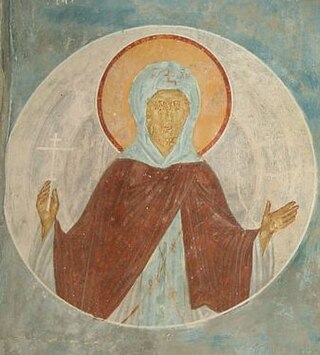
Theodora of Thessaloniki (812–892) was a Byzantine nun and saint from Aegina. Her vita is the longest ever written about a holy woman in Byzantine history and the Eastern Orthodox Church celebrates her feast day on 29 August.


